The Beauty of Tree Trunks
Our trees’ trunk can be visually spectacular. Some are slick. Some are gnarly. Some are black, brown, red or nearly white. They’re straight, and they’re contorted. They’re singular and sometimes they’re clumped.
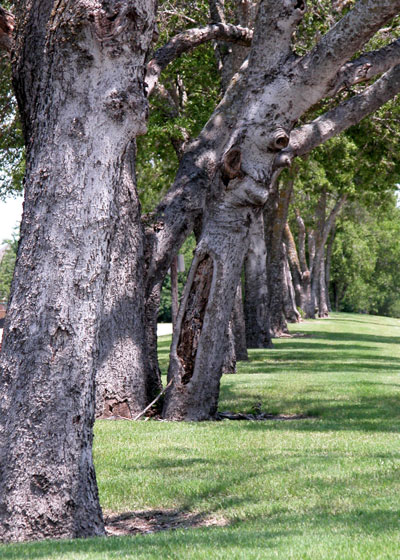
When you think of “gnarly” with relation to trees, hackberries have to come first.
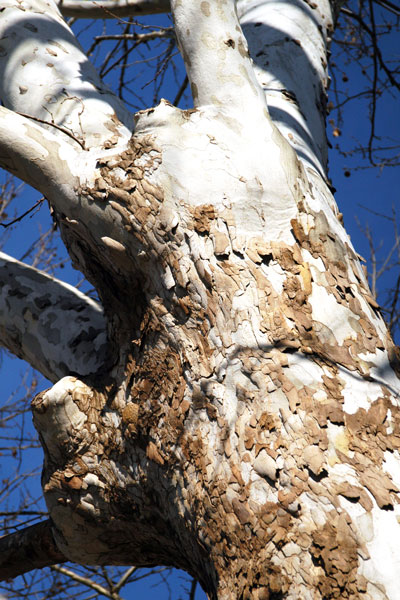
Slick bark of sycamore makes it instantly recognizable in winter.
Those trunks, however, have functions and purposes. They can be damaged. Let’s examine some of the facts you’ll want to remember.
Plant anatomy as it relates to tree trunks
Asked what function tree trunks perform, many people might say that they merely hold up the leaves. That’s a pretty simplistic way of looking at it, but that really is one of their main purposes. They grow in ways that the leaves will be displayed toward the sunlight.
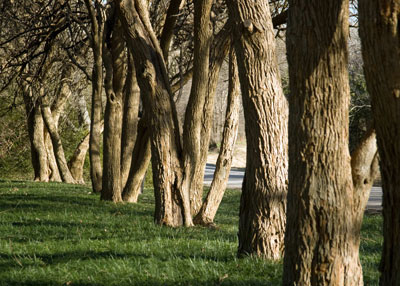
Trunks of these bois d’arcs add elegance to winter landscape, but they also carry minerals and water up to leaves and sugars down to the roots.
However, trunks are the Interstate highways of the trees’ conducting tissues. They carry water and minerals up and out to the leaves through tiny “pipelines” that make up the xylem. That’s the center portion of the trunk. It’s what makes up most of the timber of a tree.
So if the xylem is a column of these conducting tissues, just on its outside is a cylinder known as the cambium. That’s the tissue that causes a tree’s trunk to grow thicker as it produces more xylem cells on its inside and more of another conducting tissue called the phloem to its outside.
The cylindrical phloem picks up sugars the plant has manufactured during the photosynthesis process within its leaves and carries them down to the stem and root tissues, where they are either stored or used to keep the cycle going almost in perpetuity.
If I haven’t lost you yet, rejoice – it’s all about to become extremely relevant, because just outside the phloem is the tree’s bark. One of its main functions is to protect the inner tissues of the tree’s trunk. If anything happens to damage the bark, there’s a good chance the phloem and even the cambium layers will also be damaged. If the bark, phloem and cambium are stripped or cut halfway or more around the tree’s trunk at any given level, there is a good chance the tree will die. That’s how important the bark and its protection can be.
There are many ways a tree trunk can be damaged beyond the point of return. A line trimmer or lawn mower wheel can gouge through the bark. So can a dog’s chain that’s wrapped around the trunk. Dogs may peel the bark off trees’ trunks out of boredom, and rodents may chew through bark as they feed and sharpen their teeth.
You may have heard the term “girdling” in reference to trunks. I’ve lost several trees where I didn’t realize nylon twine had been used to hold soil balls in place as they were being dug. I also lost two dogwoods where a fine wire had been used to hang a price tag in place. The tag was long since gone when I bought them, replaced by loose plastic plant labels up on their branches. As they grew, the wires that were undetected down near the ground line gradually cut off the supply lines, and the trees were lost.
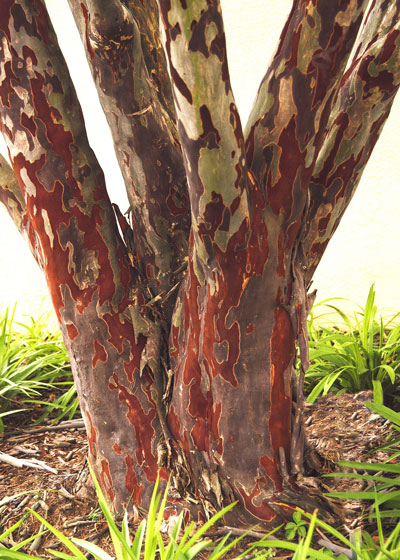
This crape myrtle trunk (Lagerstroemia fauriei) has peeling bark. As it comes off it exposes rich colors beneath.
Peeling bark probably of little concern
Bark is a dead tissue. As such, it cannot expand as a tree’s trunk grows larger. All it can do is pop off and fall to the ground in chunks and pieces of varying sizes. It’s most evident with crape myrtles and sycamores, but even stately old pecans will shed big chunks as they grow. All of this is a standard life process, and as long as you see normal bark forming beneath the peeling bark, you have nothing to worry about.
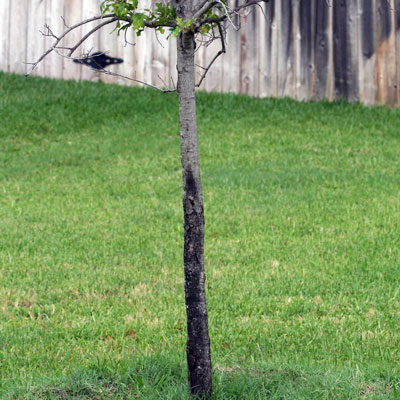
Unprotected trunk of young Shumard red oak is struggling to stay alive after sun scald ravaged its wood. Protecting it with paper tree wrap could have avoided all of these problems.
When there isn’t enough bark
A few of our common shade trees have very thin bark when they’re young. It isn’t an issue as long as the trees are growing close to one another in the nursery, but when we bring them home and plant them into the open, they’re suddenly exposed to bright sunlight. For types like Shumard red oaks and Chinese pistachios, among many others, it’s critical that you protect their trunks soon after planting with a paper wrap made specifically for the purpose. Your local independent garden center will probably have it, or you may find it in the big national stores. Wrap the trunks from the ground up, and leave the wraps in place for the first couple of years.
A couple of random considerations
Look at the place where a branch attaches to the main trunk. You’ll see a swelling, much like the delta of a river. Rather than cutting completely flush with the trunk to remove an unwanted branch, leave a quarter-inch of the branch collar in place. The wound will be smaller, and the tree will heal more quickly.
Branch angles determine a tree’s strength. Narrow angles between branches, as evidenced by Bradford and other ornamental pears, are notoriously weak. The bark can’t slough away as the branches grow larger. Moisture and debris are trapped in the crotches. Eventually, by the time the trees are 10 or 20 years old, large branches split off from their weight, leaving ugly scars in the trunks. The lesson: choose a species with strong branch angles.

